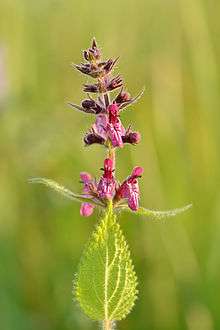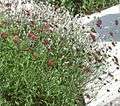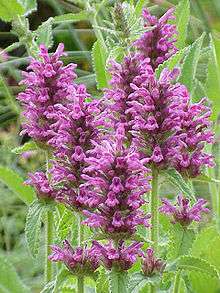Stachys
| Stachys | |
|---|---|
| | |
| Stachys cooleyae | |
| Scientific classification | |
| Kingdom: | Plantae |
| (unranked): | Angiosperms |
| (unranked): | Eudicots |
| (unranked): | Asterids |
| Order: | Lamiales |
| Family: | Lamiaceae |
| Subfamily: | Lamioideae |
| Genus: | Stachys L.[1] |
| Type species | |
| Stachys sylvatica L. | |
| Species | |
|
About 300; see text | |
| Synonyms[2] | |
| |
Stachys is one of the largest genera in the flowering plant family Lamiaceae.[3] Estimates of the number of species in the genus vary from about 300,[3] to about 450.[4] The type species for the genus is Stachys sylvatica.[5] Stachys is in the subfamily Lamioideae.[3] Generic limits and relationships in this subfamily are poorly known.
The distribution of the genus covers Europe, Asia, Africa, Australasia and North America. Common names include hedgenettle,[6] heal-all, self-heal, woundwort, betony, and lamb's ears. Wood betony, Stachys officinalis, was the most important medicinal herb to the Anglo-Saxons of early medieval Great Britain.
The Chinese artichoke (S. affinis), is grown for its edible tuber.[4] Several species are cultivated as ornamentals. Woolly Betony (S. byzantina) is a popular decorative garden plant.
Stachys was named by Linnaeus in Species Plantarum in 1753.[7] The name is derived from the Greek word σταχυς (stachys), meaning "an ear of grain",[8] and refers to the fact that the inflorescence is often a spike. The name woundwort derives from the past use of certain species in herbal medicine for the treatment of wounds.
Stachys species are used as food plants by the larvae of some Lepidoptera species, including the moths Coleophora auricella, C. lineolea, and C. wockeella, all recorded on S. officinalis. They are also widely used by the European wool carder bee (Anthidium manicatum), which scrape the hairs from the plant in order to use them for building their nests.[9]
Description
Stachys is a genus of shrubs and annual or perennial herbs. The stems vary from 50–300 cm (20–118 in) tall, with simple, opposite, triangular leaves, 1–14 cm (0.39–5.51 in) long with serrate margins. In most species, the leaves are softly hairy. The flowers are 1 to 2 cm (0.39 to 0.79 in) long, clustered in the axils of the leaves on the upper part of the stem. The corolla is 5-lobed with the top lobe forming a 'hood', varying from white to pink, purple, red or pale yellow.
Circumscription
The distinction between Stachys and other genera is unclear and has varied from one author to another. In 2002, a molecular phylogenetic study showed that Stachys officinalis is not closely related to the rest of the genus.[10] This study also found six other genera to be embedded within Stachys as it is currently circumscribed. The embedded genera are Prasium, Phlomidoschema, Sideritis, Haplostachys, Phyllostegia, and Stenogyne.
Diversity

Species include:[11]
|
|
Formerly placed here
- Agastache foeniculum (Pursh) Kuntze (as S. foeniculum Pursh)
- Leonurus japonicus Houtt. (as S. artemisia Lour.)[11]



 Stachys tenuifolia var. hispida
Stachys tenuifolia var. hispida Stachys macedonica
Stachys macedonica
References
| Wikimedia Commons has media related to Stachys. |
| Wikispecies has information related to: Stachys |
- ↑ "Genus: Stachys L.". Germplasm Resources Information Network. United States Department of Agriculture. 2006-11-03. Retrieved 2010-11-11.
- ↑ Kew World Checklist of Selected Plant Families
- 1 2 3 Harley, R. M., et al. 2004. "Labiatae". pages 167–275. In: Kubitzki, K. (editor) and J. W. Kadereit (volume editor). The Families and Genera of Vascular Plants volume VII. Springer-Verlag: Berlin; Heidelberg, Germany. ISBN 978-3-540-40593-1
- 1 2 Mabberley, D. J. 2008. Mabberley's Plant-Book third edition (2008). Cambridge University Press: UK.
- ↑ Stachys In: Index Nominum Genericorum. In: Regnum Vegetabile (see External links below).
- ↑ "Stachys". Natural Resources Conservation Service PLANTS Database. USDA. Retrieved 30 November 2015.
- ↑ Carolus Linnaeus. 1753. Species Plantarum 2:580. Laurentii Salvii. (see External Links below).
- ↑ Umberto Quattrocchi. 2000. CRC World Dictionary of Plant Names volume I, page 91. CRC Press: Boca Raton; New York; Washington, DC;, USA. London, UK. ISBN 978-0-8493-2673-8 (set). (see External links below).
- ↑ Eltz, Thomas; Küttner, Jennifer; Lunau, Klaus; Tollrian, Ralph (6 January 2015). "Plant secretions prevent wasp parasitism in nests of wool-carder bees, with implications for the diversification of nesting materials in Megachilidae". Frontiers in Ecology and Evolution. 2. doi:10.3389/fevo.2014.00086.
- ↑ Lindqvist, C. and V. A. Albert. 2002. Origin of the Hawaiian endemic mints within North American Stachys (Lamiaceae). American Journal of Botany 89(10), 1709–24.
- 1 2 "GRIN Species Records of Stachys". Germplasm Resources Information Network. United States Department of Agriculture. Retrieved 2010-11-11.
External links
- Stachys At:Index Nominum Genericorum At: References At: NMNH Department of Botany
- Stachys In: Species Plantarum At: Biodiversity Heritage Library
- CRC World Dictionary of Plant Names: R-Z At: Botany & Plant Science At: Life Science At: CRC Press
